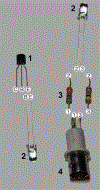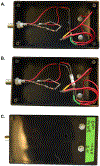A simplified LED-driven switch for fast-scan controlled-adsorption voltammetry instrumentation
- PMID: 34113744
- PMCID: PMC8189313
- DOI: 10.1016/j.ohx.2018.e00051
A simplified LED-driven switch for fast-scan controlled-adsorption voltammetry instrumentation
Abstract
Fast-scan cyclic voltammetry (FSCV) is an analytical tool used to probe neurochemical processes in real-time. A major drawback for specialized applications of FSCV is that instrumentation must be constructed or modified in-house by those with expertise in electronics. One such specialized application is the newly developed fast-scan controlled-adsorption voltammetry (FSCAV) that measures basal (tonic) in vivo dopamine and serotonin concentrations. FSCAV requires additional software and equipment (an operational amplifier coupled to a transistor-transistor logic) allowing the system to switch between applying a FSCV waveform and a constant potential to the working electrode. Herein we describe a novel, simplified switching component to facilitate the integration of FSCAV into existing FSCV instruments, thereby making this method more accessible to the community. Specifically, we employ two light emitting diodes (LEDs) to generate the voltage needed to drive a NPN bipolar junction transistor, substantially streamlining the circuitry and fabrication of the switching component. We performed in vitro and in vivo analyses to compare the new LED circuit vs. the original switch. Our data shows that the novel simplified switching component performs equally well when compared to traditional instrumentation. Thus, we present a new, simplified scheme to perform FSCAV that is cheap, simple, and easy to construct by individuals without a background in engineering and electronics.
Keywords: Basal; Circuit; Component; Dopamine; Fast-scan cyclic voltammetry; Instrumentation.
Conflict of interest statement
Conflict of interest The authors declare no conflict of interest.
Figures










References
-
- Robinson DL, Venton BJ, Heien ML, Wightman RM, Detecting subsecond dopamine release with fast-scan cyclic voltammetry in vivo, Clin. Chem 49 (10) (2003) 1763–1773. - PubMed
-
- Phillips PEM, Wightman RM, Critical guidelines for validation of the selectivity of in-vivo chemical microsensors, Trends Anal. Chem 22 (9) (2003) 509–514.
-
- Adams RN, Probing brain chemistry with electroanalytical techniques, Anal. Chem 48 (14) (1976) 1126A–1138A. - PubMed
Grants and funding
LinkOut - more resources
Full Text Sources

